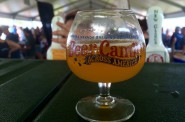How to Make a Home-Made Brew
Our fearless correspondent sets out to create a Viking style ale. Will he succeed?
Once the largest brewing city in the nation, Milwaukee is affectionately known as “Beer City,” though the old-time brewers are largely gone. Still, Miller and Pabst remain staples on the American beer market and craft brewers like Sprecher and Lakefront have arisen in Milwaukee, as beer drinkers have broadened their horizons beyond plain old pilsners. With that in mind, and as a kind of tribute to the city’s brewing tradition, I set out to make my own beer and document the experience. My choice was a lesser known beer, called Sahti and dating back to Viking times in Finland.
Tools of the Homebrewing Trade
For making a small batch of beer, in this case five gallons, a 24-quart stainless steel brew kettle with a lid is essential. This allow you to brew your beer on your home stove, while allowing a gallon’s worth of headspace for your beer to boil without boiling over.
Depending on if you’re brewing an all-grain, all-malt, or grain-malt combination, you may or may not need certain items such as a grain bag, rubber spatula, grain mill, or a hop steeper. Because this beer is an all- grain beer, no spatula is required but you do need a large grain bag and a grain mill. Fortunately, most online brew stores and local brew shops offer a milling service, making the requirement for a grain mill optional. The hop steeper is also optional but highly recommended at the brewing stage.
Other essential equipment included fifty 12 oz brown glass bottles, a brew pale with a spigot, an auto-siphon, a bench bottle capper, 50 bottle caps, a copper wort chiller, an airlock, a hydrometer, a package of sanitizer, and two 6.5 gallon glass carboys. We didn’t say this would be simple.
While some of these items are optional, such as the wort chiller and the bench capper, they are all highly recommended because they will make your life easier and your beer taste better. An example is the wort chiller and a pair of glass carboys. Because beer can spoil if not brought down to temperature quickly a wort chiller is a quick and inexpensive way to chill your beer before fermenting.
While all of your equipment can be purchased online through reputable companies such as Brewer’s Best, buying your equipment in a local shop may be a better way to go. Shops like the Purple Foot and the Northern Brewer offer expert knowledge, reasonable prices, and a wide array of ingredients and equipment essential to the hobby.
Sanitation
A strict code of sanitation is required of brewers. Because yeast is a living organism even the slightest impurity added to your beer at any point of the brewing process can cause your beer to sour or alter the flavor. Anything that your beer will come into contact with has to be thoroughly sanitized beforehand. This may seem like a daunting task but with a one-step sanitizer product, sanitation will take around a 20 minutes of your time and save you the peril of tasting your beer for the first time only to be sickened by the taste.
Ingredients vary beer to beer. For a Viking Age Sahti some strange ingredients are required such as juniper branches and their berries, while common ingredients such as hops are left out. Because of pesticides and other things that could ruin your beer, the Viking age recipe has been altered into a modern one. This recipe includes crack malts such as Pale 2-row, Rye, Munich, and Crystal 120L, as well as Cascade hops, juniper berries, grains of paradise, and American Ale yeast.
Brewing
Brewing a beer is a lot like cooking a soup. Add three gallons of water to your brewing kettle and bring to a strong boil. Chill the remaining two gallons of water. Once the water is boiling, place your cracked grains and berries in a grain bag and add the bag to your water. This begins a process of steeping the grains, which is extracting the natural fermentable sugars from the grains and berries, flavoring the wort, or unfermented beer. Depending on the recipe, the hops are added during the boil. In this case, the hops are added at the beginning, but to avoid a mess, use a hop steeper.
After 60 minutes of constant boiling the wort is ready to be chilled. However, because this is an all-grain recipe an extra step is required. The grains have to be bled of the water they soaked up in the last hour.
Bleeding the grains is a long task best undertaken using a separate kettle with a colander. By emptying the grains into the colander you can let them drain into the kettle while you proceed to cool your wort, but don’t forget to put the grain water back into the wort.
Cooling and Fermenting
Once the boil has been terminated the first order of business is to get the wort into a utility sink as soon as possible. There are two methods to cool the wort; one is using the optional copper wort cooler which pumps cold water through the coils submerged in your wort. The other is the classic ice water bath. Though the ice bath works well enough, the wort cooler gets the job done in around 15 minutes.
Now that your beer is cool, it is time to siphon it into which ever carboy you have decided is the primary fermenter. Once the beer has been siphoned into the primary, add the yeast and plug the top of the carboy with the airlock. Place the carboy in a cool, dark place and over the next 24 hours the yeast will began to consume the sugars in the wort, turning it into alcohol.
After 7-10 days in the primary fermenter, your partially alcoholic beer should be siphoned into the secondary fermenter. This time, however, be careful not to siphon the sludge at the bottom of the primary unless you want a foggy beer. After another 5-7 days, activity in your airlock should cease, meaning it’s time to bottle the beer.
Ale or Lager?
Lagering requires special equipment that can keep the beer at a specific temperature. While most commercial beers are lagers, most homebrews are ales and can be stored in a dark basement. By tradition, Sahti is an ale.
Bottling and Capping
Capping is a quick and easy process. Simply fill each of your fifty bottles with 1/8th teaspoon of corn sugar and rack your finished beer into a beer pale with a spigot. You then use the spigot fill the bottles to the base of the neck and set aside for capping.
When your bottles are filled and capped, put them in a dark place. After 7-14 days, the beer will hiss and emit a vapor upon opening. This means the beer is carbonated and ready to be chilled and enjoyed.
The Moment of Truth
It’s been a month and my Sahti is finished. At first glance, the beer has a murky, brown appearance, but it has a smooth mouth-feel, and thick head, and a high alcohol percentage of 9.5 percent. Flavor-wise, the beer has a mild bitterness from the hops complemented by the sweetness and aroma of the berries making this beer a refreshing modern spin on an ancient brew. Cheers!
Local Brew Shops
The Purple Foot
3167 S. 92nd Street, Milwaukee WI. 53227
414-327-2130
Open Monday – Friday 9:30-6:00, Wednesday 9:30 to 8:00, Saturday 9:30-4:00. Closed Sunday
The Northern Brewer
1306 S 108th St, Milwaukee, WI 53214
414-935-4099
Monday-Friday: 10:00 – 7:00 pm, Saturday: 9:00 – 6:00 pm, Sunday: 10:00 – 5:00 pm
Beer City
-
The Crowd Rules At MobCraft Brewery
 Jul 7th, 2016 by Joey Grihalva
Jul 7th, 2016 by Joey Grihalva
-
Sierra Nevada Beer Camp Was a Winner
 Jun 13th, 2016 by Joey Grihalva
Jun 13th, 2016 by Joey Grihalva
-
The Rise of O’so Brewing Co.
 Dec 1st, 2015 by Christophor Rick
Dec 1st, 2015 by Christophor Rick
























